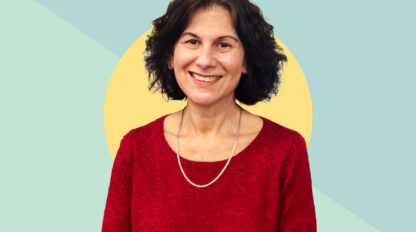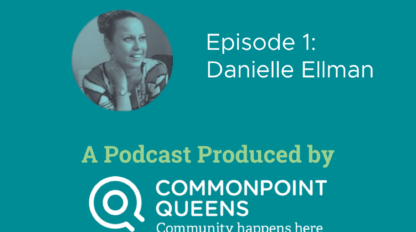Sister’s ‘Dark Time’ Inspires Couple to Serve Those With Disabilities
The weekend before Thanksgiving, Kenny Sher led his mother by the hand into the dining room of Commonpoint Queens’ Sam Field Center in Little Neck, Queens.
A dozen tables decorated with paper turkeys surrounded a quickly filling dance floor. Mr. Sher, 55, was among the first to arrive at the event, organized by A Time for Us, a program for adults with developmental disabilities.
“The program has made Kenny’s life so much better,” said his mother, Judith Sher, 80. “He used to sit in the corner and do nothing, but now he socializes and he’s smiling when he leaves.”
For more than 10 years, Mr. Sher has regularly attended program events, hosted by the Commonpoint Queens Sam Field Center, a beneficiary agency of UJA-Federation of New York, one of the eight organizations supported by The New York Times Neediest Cases Fund. The Y distributes money from the fund to some of its clients in need. A Time for Us holds nine events a year, each attended by at least 75 people, including participants and volunteers.
“This is a safe haven,” Robin Topol, a program director at Sam Field, said. “A place where people come and belong and are wanted.”
At the Thanksgiving event in the Little Neck neighborhood, Anita Swerdin, who works part-time at Sam Field and also volunteers there, leaned close to Mr. Sher, who can speak few words, and reviewed the menu. He repeated in high-pitched glee: “Turkey!” “Stuffing!” “Pumpkin pie!”
Mrs. Swerdin, 75, and her husband, Burt, 79, of Oakland Gardens, Queens, have been involved with the program for four years. They know firsthand the numerous benefits that programs like A Time for Us can offer.
His sister, Doris Swerdin, developed brain damage when she had whooping cough as a toddler. Mr. Swerdin, 11 years her junior, said he grew up idolizing his sister, who could read at a basic level and would help around the family’s kitchen in Coney Island, Brooklyn. But at 18, when she aged out of her school, the family discovered the lack of opportunities and social services available to her and others with similar disabilities.
When Mr. Swerdin met his wife in 1960, “the most important thing was that she understood about Doris,” he said. When she accepted his sister with open arms, he added, “I knew I had a partner in life.” They married two years later.
As Ms. Swerdin’s needs increased, her family moved her in 1967 to Letchworth Village, a state-owned institution in Rockland County for developmentally disabled people. Unsatisfied with the care, but faced with few alternatives, the Swerdins wrote to federal lawmakers, even President Gerald Ford, urging the government to put more money toward treatment programs.
“They needed to have some sort of life outside their disabilities,” Mrs. Swerdin said. “Instead, they were literally sitting in waste.”
When Ms. Swerdin was living at Letchworth, Geraldo Rivera, then a reporter for WABC-TV in New York, investigated it and another institution for disabled people, winning a Peabody Award in 1972 for exposing overcrowding and poor care in both institutions. Though the reporting shed a light on the conditions at Letchworth, it remained open until 1996. In 1975, she was transferred to a newly opened institution, now called New Hope Community, which Mrs. Swerdin described as an oasis for people with intellectual and developmental disabilities.
In eight years at Letchworth, where the beds were lined up one after the other, Ms. Swerdin had only one small drawer for clothes. But at New Hope, she shared a bedroom with just one other resident — and eventually had a room to herself — and had access to a kitchen and a patio to entertain visitors. A few years after moving in, she was hired for her first job, working on an assembly line, and took art courses at a community college. Ms. Swerdin lived there for three decades. She died after a stroke in 2005 at age 78.
In her memory, the Swerdins have continued serving those with mental disabilities. At the Thanksgiving event, Mrs. Swerdin and other volunteers passed around coloring pages depicting turkeys. She offered Mr. Sher, one of the attendees, a handful of colored pencils. He selected only the green and the brown, sketching grass beneath the birds’ feet while leaving the turkeys in black and white outline.
As a baby, the progress of Mr. Sher seemed to mirror that of his older brother, his mother said. He chattered and began walking by 11 months. But as a toddler, he stopped talking and turned inward.
In 1967, Ms. Sher was told her younger son had autism. She and her husband put him through private school. In the early 1980s, when he was in his late teens, special education services began catering to those with autism as the developmental disorder became better understood.
Then the services stopped when he turned 21, Ms. Sher said, “but he still had the same need.”
For years, Ms. Sher said, she and her husband felt alone in the struggle. But as they met more parents of children with similar needs, they learned of additional programs and opportunities. After Ms. Sher had a breast cancer scare in her mid-50s, the family began thinking about long-term care.
When Mr. Sher was about 30, his parents moved him into his first group home. He now spends five days a week in a 10-person home in Queens and returns to his parents’ home in Forest Hills each weekend. Mr. Sher has also been receiving speech therapy, which his parents say has greatly aided his communication skills.
With the help of A Time for Us, Mr. Sher, who is shy and reserved, has started opening up to new people. He looks forward to the events, his parents said. He smiled almost constantly throughout the two-hour holiday gathering.
In earlier years, the music blaring from the speakers would have bothered him, his mother said. But now he taps his fingers on his knee along to the music.
“He’s my dance partner,” Mrs. Swerdin said, leading him to the floor. A small dance circle formed. Mr. Sher stood still, smiling and watching the others. Warming to “Y.M.C.A.” by the Village People, he slowly shifted from foot to foot. Then, rocking back and forth and holding onto Mrs. Swerdin’s hands, they waved their arms up and down together.
Outside the social hall, Mr. Swerdin craned his neck to see people inside, feasting and dancing. “Seeing everyone smiling is such a warm feeling,” he said.
“We’ve been through such a dark time,” Mrs. Swerdin added, referring to their struggles with his sister’s care. “So now to be here, our hearts just sing to see such light.”


